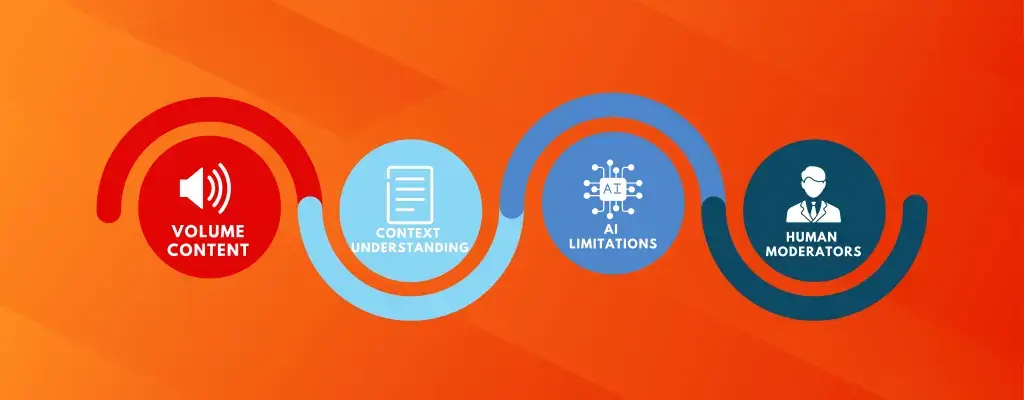The online world has become an integral part of our lives. Out of roughly 8 billion people on Earth, around 5.44 billion have access to the internet, which translates to around 67.1% of the global population. This growing number of online users reflects the sheer amount of user-generated content (UGC) produced daily.
However, UGC can be inappropriate and harmful. Imagine scrolling through your favorite social media feed and encountering harmful or offensive content. This will not only ruin your online experience but also affect your perception of the brand or platform. Thankfully, content moderation is here to help.
Content moderation is crucial in maintaining the integrity and safety of online platforms. It protects users from harmful content, including hate speech, violence, and misinformation. Similarly, content moderator services safeguard brand image and business reputations.
In this blog, we’ll explore how content moderation works and why it is essential for both users and businesses in today’s digital landscape.
What is Content Moderation?

Content moderation refers to monitoring, reviewing, and managing content on various online platforms. The goal of content moderation is to ensure all types of UGC comply with community guidelines and legal and ethical standards.
Here are the most common types of UGC requiring moderation:
Text
Textual content includes user comments, forum posts, blog responses, and social media updates. Moderators check textual content for offensive language, spam, hate speech, and misinformation. Similarly, text moderation services monitor customer reviews on e-commerce sites to ensure they are genuine, relevant, and free from defamatory remarks.
Images
Images refer to the photographs or graphics uploaded by users. Moderators review images for explicit content, violence, and inappropriate subject matter. Image moderation services are crucial for social media platforms, dating sites, and content-sharing websites.
Videos
User-generated videos are the lifeline of content-sharing platforms such as YouTube and TikTok. Moderators review videos for violent, explicit, or harmful content. Similarly, real-time moderation solutions ensure the safety and integrity of live streams.
Different Ways to Approach Content Moderation

Besides different types of moderation solutions to address different types of UGC, the intricacies of content moderation also includes different ways to approach it. Depending on the techniques, tools, and strategies of an online platform, content moderation can be classified as:
Automated Moderation
Automated moderation involves using artificial intelligence (AI) and advanced algorithms to scan and filter user-generated content. These systems can quickly identify and address inappropriate materials using cutting-edge technologies such as natural language processing, computer vision, and machine learning.
Human Moderation
Despite advancements in automated moderation, human moderators remain crucial in content moderation. They understand nuances, context, and cultural differences that automated moderation systems might overlook. Thus, their qualitative judgment is crucial in ensuring accurate moderation outcomes.
Hybrid Moderation
Hybrid moderation combines the speed and efficiency of automated moderation with the contextual understanding and judgment of human moderators. This approach uses the strengths of both methods to create a comprehensive and effective moderation system. The usual setup for hybrid moderation involves automated moderation for initial content screening and human moderators for reviewing flagged content.
From Human to AI: How Does Content Moderation Work?

Content moderation relies on a variety of technologies and tools to ensure the effectiveness of content screening and curation. These tools can be broadly categorized into those used in automated content moderation and those designed for human moderators.
Technologies Behind Content Moderation
AI is the backbone of various technologies that power efficient and scalable content moderation. These technologies include:
Machine Learning
Machine learning algorithms trained on large datasets can recognize patterns associated with harmful content, including hate speech, explicit material, and misinformation.
Natural Language Processing (NLP)
NLP technologies analyze text to understand context, sentiment, and depths of human language. They can detect subtle nuances in language that may indicate abusive or harmful behavior.
Computer Vision
Automated moderation uses computer vision technology to analyze images and videos. These advanced algorithms can detect explicit content, violence, and other prohibited material within visual content.
Tools in Content Moderators’ Arsenal
Human moderators rely on specialized software and tools to review and manage flagged content effectively.
Here are some content moderation software and tools that complete the moderators’ arsenal:
Content Management Systems (CMS)
CMS helps moderators organize, review, and manage user-generated content. It provides an easy-to-use interface where moderators can review and categorize the flagged content efficiently.
Collaboration Tools
Moderation often requires teamwork. Collaboration tools enable moderators to communicate, share insights, and make collective decisions about complex content issues. These tools can be in the form of messaging apps, online workspaces, or project management platforms.
Analytics and Report Mechanisms
Moderation platforms often include analytics tools to track trends, measure moderation effectiveness, and identify emerging issues. Data from moderation reports can help with the continuous improvement of moderation strategies and policies.
Mapping the Content Moderation Process
With the combination of the above-mentioned technologies and tools, content moderation often operates on the following steps:
- Users upload text, images, videos, or other content to an online platform.
- Automated moderation systems perform a preliminary scan to detect obvious violations of community guidelines or legal standards.
- Potentially harmful or inappropriate content gets flagged by the AI moderator or reported by platform users.
- Human moderators review the flagged content in detail. They determine the severity of the violation and take appropriate actions, including approving, editing, or removing content. In most severe cases, human moderators may issue suspensions or account termination.
- Users receive a notification or message regarding the moderation decision. They may have the opportunity to appeal decisions and request a secondary review process.
5 Reasons Why We Need Content Moderation

Content moderation is crucial for the health and integrity of online platforms. Here's a quick rundown of the critical reasons why content moderation is necessary:
Protecting Users
One of the primary purposes of content moderation is to protect users from harmful content. Moderators create a safer and more welcoming environment for all users by filtering out explicit material, hate speech, cyberbullying, and other forms of abusive content.
Legal Compliance
Content moderation ensures that the online platform adheres to various laws and regulations governing online content, including protecting minors from explicit content, preventing defamations, and adhering to copyright regulations. Non-compliance can result in legal penalties and loss of credibility.
Maintaining Community Standards
Online platforms establish community standards to define acceptable behavior and content. Content moderators ensure that users follow these standards. By enforcing compliance, content moderation promotes a positive and respectful community that values its user base.
Preventing Misinformation
Misinformation can spread like wildfire in today's digital age. Content moderation helps identify and remove false information. Doing so prevents the spread of rumors, fake news, and misleading content. Moreover, preventing misinformation can help maintain informed and truthful online discourse.
Enhancing User Experience
Online communities free from disruptive content and behavior can enhance user experience. Content moderation filters out spam, offensive content, and irrelevant materials to create a more enjoyable, engaging, and productive digital space for users.
Challenges in Content Moderation

Content moderation is not as simple as flagging and deleting content. It is a demanding task that comes with numerous hurdles, such as:
Content Volume
The most glaring challenge of content moderation in today's digital age is the sheer volume of content produced daily. Content moderation companies may struggle to keep up with the influx of UGC, and human moderators cannot process it manually. This is why it's crucial to employ AI systems that will review UGC automatically.
Context Understanding
Understanding the context and cultural nuances of content can be a daunting task. Content moderators must always consider the situational and cultural appropriateness of the content. Content considered offensive in one culture could be acceptable in another. Misinterpretations can lead to wrongful content removal or failure to address harmful material appropriately.
AI Limitations
While AI for content moderation has advanced significantly, it still has limitations in accurately detecting harmful content. AI can struggle with understanding sarcasm, irony, and context. As such, it is possible for AI-powered automated moderation to give false positives or negatives when flagging content.
Emotional Toll on Human Moderators
Human moderators often consume graphic, violent, and disturbing content while moderating. These materials can take a severe emotional toll on their mental health and well-being. Constant exposure to such harmful content can lead to stress, anxiety, and burnout.
Future of Content Moderation

Technological advancements will continue shaping the future of content moderation. From AI to hybrid models, here’s what we can foresee in the future of content moderation for now:
Advances in AI Technologies
AI and machine learning algorithms will continue to evolve, promising significant improvements in content moderation accuracy. Future advancements will likely center around improving NLP for contextual understanding and adaptive learning systems for coping with emerging trends. AI content moderation will also adapt multimodal analysis to enable more accurate detection of harmful elements in multimedia content.
Dependability of Hybrid Models
The future of content moderation will see a greater reliance on hybrid models which combine AI-powered moderation and human expertise. This approach will optimize efficiency and accuracy while addressing the limitations of each method. AI will continue to handle the bulk of initial content screening while human moderators review content flagged by the automated moderation or reported by users.
Ethical Consideration and the Need for Transparency
The continuous advancement of technologies highlights the increasing importance of ethical considerations and transparency in moderation. Platforms must address concerns regarding privacy, bias, and accountability to maintain user trust and comply with regulations.
Digital Future: Why Content Moderation Matters Now More Than Ever

Content moderation is crucial in today's digital landscape. In addition to protecting users and ensuring legal compliance, content moderation services also maintain community standards, prevent misinformation, and enhance user experience.
Content moderation is not an easy task. It comes with various challenges. The overwhelming volume of content produced every day already poses a challenge for content moderators. Moreover, the need for contextual understanding, AI limitations, and the emotional toll on human moderators make content moderation and management more difficult.
To navigate the complexities of content moderation, you need a reliable content moderation outsourcing partner like Chekkee.
Chekkee is a leading content moderation company that combines advanced technology with expert human moderators to provide comprehensive content moderation solutions. From profile and social media moderation to user-generated content moderation, Chekkee got you covered.
With Chekkee, you can confidently manage the challenges of content moderation and create a safer, more positive online environment for your community.In this fast-paced world, remember, the future is now. Contact us today!


